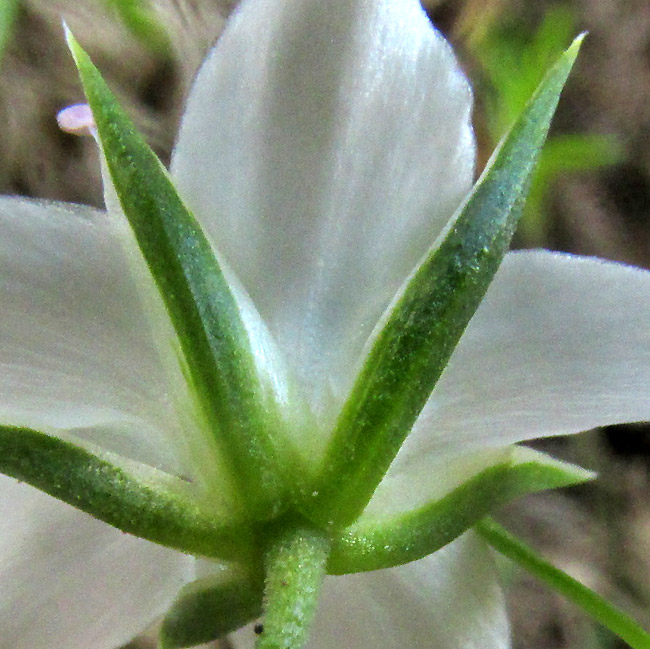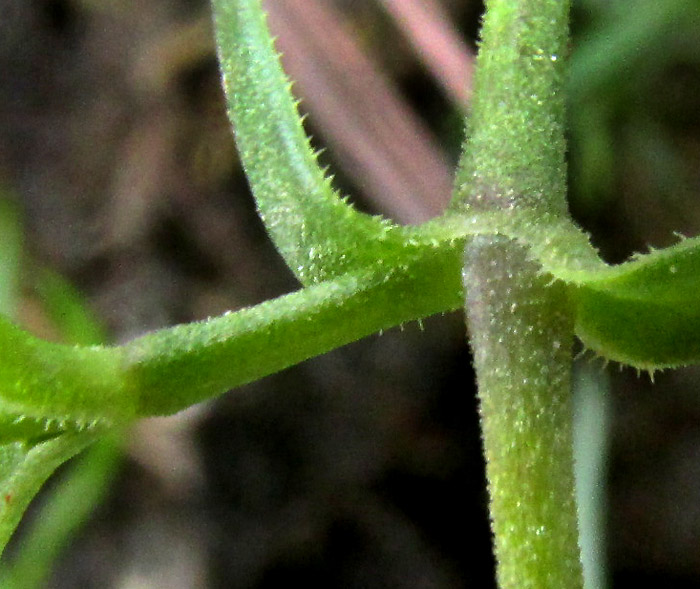Excerpts from Jim Conrad's
Naturalist Newsletter
Entry from field notes dated September 1, 2023, taken in Los Mármoles National Park in the Eastern Sierra Madre mountains, Hidalgo state, MÉXICO, along steeply climbing road heading eastward out of town of Trancas {on maps designated "Morelos (Trancas)"} toward Nicolás Flores; juniper/pine forest on limestone bedrock; elevation ~2,300m (~7,550ft); ~N20.80°, ~W99.24°
ARENARIA LYCOPODIOIDES

On a steep roadcut across a rocky slope, the above wildflower dangled from a tangle of weeds at the roadcut's top, groping toward sunlight.

Like an illustration of flower parts in a text book, up close the flowers displayed simple variations on basic features. Five green sepals emerged between five white petals, which couldn't have been more typical, but then instead of five stamens, there were ten, each slender filament bearing a slightly pinkish anther. Atop the clearly visible, green, oval, pea-like ovary, arose not a single style, but three.

The calyx's sepals were long and slender, gradually diminishing in width to sharp, stiff tips. The sepals' margins grew thin and became white, and the midribs stood out somewhat.

Our wildflower's stems and narrow leaves were short-hairy, and often -- as seen above -- leaf clusters sprouted on short stalks from leaf axils. For identification purposes, these were important field marks, for the flowers were very similar to other species of this plant type with different kinds of hairs, or no hairs at all, and differently shaped leaves. That's the case with the Spreading Sandwort, with very similar blossoms, but much broader leaves and taller hairs. Note that our plant produces no stipules at its leaf bases.
This is another sandwort, though bearing no English name other than just sandwort, a name often applied to any species of the genus Arenaria. Sandworts belong to the Pink or Carnation Family, the Caryophyllaceae. Over 200 species are recognized. Many species are very similar to one another, and identifying them to species level can be hard. The comprehensive 2022 study by José Luis Villaseñor and others entitled "Riqueza y distribución de la flora vascular del estado de Hidalgo, México lists seven Arenaria species for the upland central Mexican state of Hidalgo.
Our roadcut wildflower is ARENARIA LYCOPODIOIDES. In the field it's mainly distinguished from other sandwort species by its narrow leaves, often with other leaves sprouting on short stalks from the main stem's leaf axils, and its short-hairiness. The Spreading Sandwort mentioned above has a narrow-leafed variety similar to our plant, but its hairs are much longer.
As an aside, identifying our Arenaria lycopodioides was tricky because all technical literature I could find base their detailed descriptions on the appearance of dried and pressed herbarium specimens. Such descriptions consistently described our plant's main distinguishing feature as its leaves displaying conspicuously enlarged midribs and margins. These features may develop in dried plants, but on living plants, as the above pictures show, leaf midribs and margins are not conspicuously enlarged.
Arenaria lycopodioides is endemic just to most of upland Mexico south into Guatemala. It's described as prospering in a wide variety of upland habitats, from juniper to fir forests and grasslands, and habitats resulting from those environments' disturbance, up to about 3400m high (11,200ft).
I read that our sandwort is medicinal, though it's not said which parts are used or how to use them. On the Internet, numerous websites sell packages of arenaria herbs. Pictures of package contents appear to show dried stems and leaves, for the brewing of a medicinal tea. The WebMD.Com website says that "People take arenaria rubra for infections of the kidney, bladder, or urethra (urinary tract infections or UTIs) and for kidney stones, but there is no good scientific evidence to support these uses."
It may be useful to remember that in the past many people believed in the Doctrine of Signatures, which assures us that plants indicate to us how they're supposed to be used therapeutically. In that light, plants tending to grow on rocks, which often is the case with sandworts, are breaking down the rocks, so obviously they should be used for removing kidney stones.